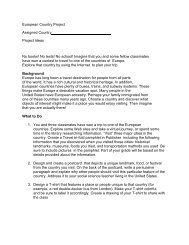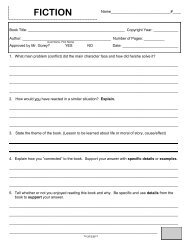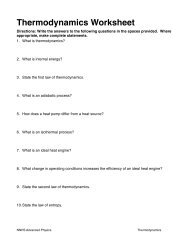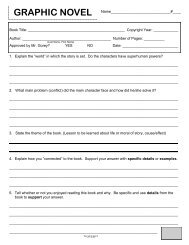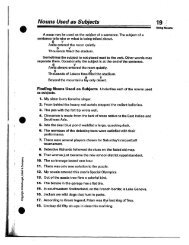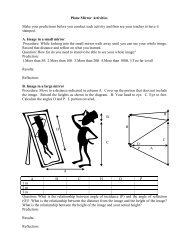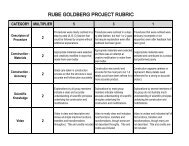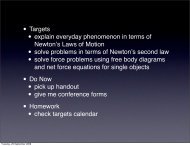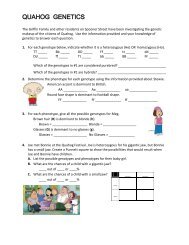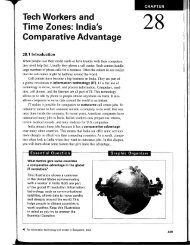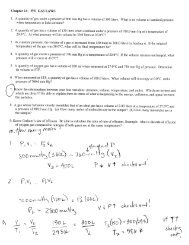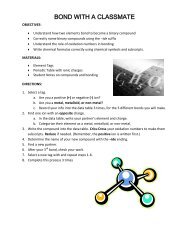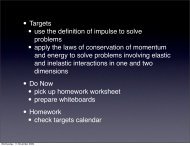First Semester Lab Manual - Naperville Community Unit School ...
First Semester Lab Manual - Naperville Community Unit School ...
First Semester Lab Manual - Naperville Community Unit School ...
Create successful ePaper yourself
Turn your PDF publications into a flip-book with our unique Google optimized e-Paper software.
NNHSGeneral Physics<strong>First</strong> <strong>Semester</strong><strong>Lab</strong> <strong>Manual</strong>Mechanics
<strong>Manual</strong> Number:Name Year Used ConditionIssuedConditionReturnedThis manual is the property of <strong>Naperville</strong> <strong>Community</strong> <strong>Unit</strong> <strong>School</strong> District 203.Many of these labs were created by Micki Wilverding of <strong>Naperville</strong> North High <strong>School</strong>.Additions and revisions were made by Kevin Farrell, Mark Rowzee, Jason Ryan, and GeoffSchmit of <strong>Naperville</strong> North High <strong>School</strong>.This work is licensed under the Creative Commons Attribution-Noncommercial 3.0 License.To view a copy of this license, visit http://creativecommons.org/licenses/by-nc/3.0/ or send aletter to:Creative Commons171 Second Street, Suite 300San Francisco, California 94105USA.General Physics 2 <strong>Naperville</strong> North HS
Table of ContentsFORMAL EXPERIMENT REPORT FORMAT 4INFORMAL EXPERIMENT REPORT RUBRIC 9REFLECTION DESCRIPTION 10EXPERIMENT 2.1: CONSTANT VELOCITY 11EXPERIMENT 2.2A POSITION-TIME GRAPHS OF HUMAN MOTION 13EXPERIMENT 2.2B POSITION-TIME AND VELOCITY-TIME GRAPHS OF HUMANMOTION 14EXPERIMENT 2.3: ACCELERATION OF A FREELY FALLING PICKET FENCE 15EXPERIMENT 2.4: BALL AND CAR RACE 17EXPERIMENT 3.1: THE PAPER RIVER – RELATIVE MOTION AND VECTORRESOLUTION 19EXPERIMENT 3.2: TRAJECTORY OF A PROJECTILE 21EXPERIMENT 3.3: BALLOON LAUNCHER 25EXPERIMENT 4.1: MASS AND WEIGHT 27EXPERIMENT 4.2: NEWTON’S SECOND LAW 29EXPERIMENT 4.3: FRICTION 31EXPERIMENT 4.4: FORCES IN EQUILIBRIUM – DETERMINING THEEQUILIBRANT 33EXPERIMENT 5.1: WORK AND POTENTIAL ENERGY 37EXPERIMENT 5.2: WORK AND KINETIC ENERGY 39EXPERIMENT 5.3: WORK AND POWER 41EXPERIMENT 6.1A: CONSERVATION OF MOMENTUM OF EXPLOSIONS 43EXPERIMENT 6.1B: CONSERVATION OF MOMENTUM OF COLLISIONS 45EXPERIMENT 7.1: TORQUES IN EQUILIBRIUM (JENSEN BAR) 47General Physics 3 <strong>Naperville</strong> North HS
eader would understand the steps followed. Write a summary. Demonstrate that youknow what to do during the experiment. The procedure must be in your own words.7. Data and Resultsa. Data TableAfter reading the procedure, decide what variables will be measured andcalculated during this experiment and include them in the heading of your datatable and include units. Your data should be on a page by itself with roombelow to show sample calculations for the first two calculations. See thebelow sample.Sample Data TableDistance Traveled by an Object During Three TrialsTrial Distance (m) Time (s) Speed (m/s)1 0.24 0.020 122 0.30 0.030 103 0.36 0.060 6.0Sample Calculations: speed = 0.24 m / 0.020 s = 12 m/s; 0.30 m / 0.030 s = 10 m/sb. DataMeasurements made during the investigation are to be recorded in theprepared data table. All entries should be made in ink. If you make an errorneatly cross it out and write in the new data. Have your instructor initial orstamp the data table before you go. Note: you may type your data table foryour final report but you must include the original stamped data table at theback of your report.c. ResultsThese are your calculated values and answers to any questions in theprocedure. Include percent error when appropriate. Remember to showsample calculations below your data table.d. Procedure QuestionsAny questions asked in the procedure should be answered under the Data andResults sections.e. GraphInclude a graph when instructed and follow the requirements listed below.General Physics 5 <strong>Naperville</strong> North HS
All graphs must be on graph paper. If permission is given to include acomputer-generated graph, it must contain a grid on it.Each graph must contain the following:• Title that describes the data graphed.• An appropriate scale that uses most of the graph paper but is easy tointerpret.• (0,0) at the origin. Do not use to signify that part of the scale is omitted.• <strong>Lab</strong>els for the independent variables (x-axis or abscissa) and for thedependent variable (y-axis or ordinate).• <strong>Lab</strong>els for the units for the variables.• Draw the best-fit line that includes as many points as possible with thesame number below the line as above it. Never connect the dots. For acomputer-generated graph, include the equation of the best-fit line and theR 2 value.• State the type of curve: linear, direct, inverse, or exponential.All lines do not go through (0,0). You do not take data at (0,0) so you mustthink about your experiment and decide if the data would logically include(0,0). If it would, then you must include (0,0) as one of your points.Slope: If the experiment requires you to find the slope, you must show yourcalculations (y2 - y2) / (x2 - x1) on the graph as well as the point that youused.General Physics 6 <strong>Naperville</strong> North HS
8. Error AnalysisIn the laboratory there are three kinds of error:• Personal – Mistakes that should be eliminated and not reported unless youdiscover the mistake after you completed the experiment.• Systematic errors – Measurements that exhibit a known bias. That is, you candetermine that the measured value is always either greater than or less than theactual value. These biased errors may be associated with particularmeasurement instruments or techniques. Example: friction during anexperiment may reduce the speed of an object whereas a slanted surface mayincrease the speed of an object moving in the direction of the slant or decreasethe speed of an object moving against the slant.• Random errors – Result from the precision of unbiased measurements. Thelast digit of any measurement, analog or digital, is an estimate. Randomerrors may also result from unknown and unpredictable variations in theexperimental situations including mechanical vibrations or electrical noise.Random and systematic errors, unlike personal errors, may not be able to beeliminated, but should be kept to a minimum by the design of the experiment and thecare taken by the experimenter.Your discussion of error should include the following:1. The estimated uncertainty for each measuring device and the maximumpercent uncertainty.General Physics 7 <strong>Naperville</strong> North HS
Informal Experiment Report RubricPoints vary from experiment to experiment; additional points may be earned by exceeding expectationsCategoriesDoesn’t MeetExpectationsMeets ExpectationsExceeds ExpectationsData(varies)Experimentalobservations superficial,careless, or incomplete.All experimental observations arethoughtful, neat, complete, anddescribed in complete sentences.Sample calculations provided.All experimental observations are accurate, detailed,thoughtful, neat, complete, and described in completesentences. Sample calculations provided.DiscussionQuestions(varies)Answers are superficial,inaccurate, incomplete,or not based on theobservations.All answers are detailed, thoughtful,accurate, based on the observations,and typed in complete sentences.All answers are insightful, detailed, thoughtful, accurate,based on the observations, and typed in complete sentencesand show understanding about how the expected results andobservations may differ.ErrorAnalysis (5)Analysis is superficial,inaccurate, incomplete,or based on personalerrors.Analysis is detailed and accurate,considers some of the systematicand random errors, presentsevidence of these errors, and istyped in complete sentences.Analysis is detailed and accurate, considers anddistinguishes many of the systematic and random errors,presents evidence of these errors, describes how these errorsimpacted the observations, proposes how these errors wereor could be minimized, and is typed in complete sentences.Conclusion(5)Conclusion issuperficial, inaccurate,or shows little evidencethat the purpose of theexperiment wasachieved.Conclusion is detailed and accurate,summarizes the purpose of theexperiment, shows evidence thatthis purpose was achieved, and istyped in complete sentences.Conclusion is insightful in that it can be applied to new butsimilar situations, is detailed and accurate, summarizes thepurpose of the experiment, shows evidence that this purposewas achieved, and is typed in complete sentences.Reflection(5)Reflection is superficialor shows little evidenceof careful thought.Reflection is detailed andthoughtful, shows evidence ofreflection on multiple aspects, and istyped in complete sentences.Reflection is insightful, detailed, and thoughtful; showsevidence of reflection on many aspects; and is typed incomplete sentences.
Discussion Questions1. For the variable on the horizontal axis, why did you place it there? For the variableon the vertical axis, why did you place it there? Why aren’t these two variables onthe other axis?2. For this experiment, what does the slope of the line on your graphs represent?3. How do the slopes vary for vehicles with different speeds?4. What is the value of the y-intercept for the graph corresponding to each vehicle?What does y-intercept represent for this experiment? What could account for a graphthat does not go through (0, 0)?5. What is the equation for each graph? Why is this equation useful?General Physics 12 <strong>Naperville</strong> North HS
Experiment 2.2A Position-Time Graphs of Human MotionIntroductionIn this and several experiments to follow, you will use the DataStudio computer program totake data. In this experiment, you will be given directions to walk either towards or awayfrom a motion sensor. When the program is activated the computer will show a graph ofyour real-time position vs. time.PurposeAnalyze motion in terms of reference point, distance and position by using real-time data.Procedure1. Take a laptop from the cart and log in to the HS domain.2. Launch DataStudio (icon on the desktop) and open the DataStudio file for Experiment2.2A from the Hand Out\General Physics\Experiments folder on the Global share asdirected by your instructor.3. Place a 2-m stick on the counter or the floor so that the “0” end is about 30 cm fromthe motion sensor. The sensor only records beyond 30 cm. When you are ready totake data, hold a book vertically in line with the motion sensor. Click on the Startbutton. When you are ready to stop acquiring data, click on the Stop button. If youwish to delete a data set, click on the data set (e.g., Run #1) in the Data pane andpress the delete key. Follow the directions below for steps 1-3.4. Start at 1.2 m along the meter stick and walk toward the motion sensor for 5 secondsand then stop for 5 seconds. Print the graph. <strong>Lab</strong>el the graph “Step #4.” Eachmember of the group should have a copy.5. Again start at 1.2 m and walk toward the motion sensor for 5 seconds and then walkbackwards (without turning) for 5 seconds. Print the graph. <strong>Lab</strong>el the graph “Step#5.” Each member of the group should have a copy.6. Now start at the “0” end of the meter stick. Walk backward for 3 second, stand stillfor 4 seconds, and walk forward for 3 seconds. It is important that this graph is fairlystraight and that you return close to your starting point. You may have to practiceseveral times. When you get a good trial, delete the others. Resize your graph byclicking on the “Scale to Fit” button (far top-left button). This button resizes thegraph so that the data is spread out over a larger area. Have your instructor checkyour graph and then print. <strong>Lab</strong>el the graph “Step #6.” Each member of the groupshould have a copy. Select the table window and print a copy of the table for eachmember of the group.7. Answer the questions on the data sheet.General Physics 13 <strong>Naperville</strong> North HS
Experiment 2.3: Acceleration of a Freely Falling PicketFenceIntroductionIn this experiment, you will again use the DataStudio computer program to take data. In thisexperiment, you will drop a picket fence (a clear plastic strip with uniformly spaced opaquebands) through a photogate. The photogate turns on when it is blocked by the opaque stripsand turns off when not blocked. The width of the opaque strip has already been entered intothe computer and therefore the computer can graph the position, velocity, and acceleration ofthe picket fence.PurposeAnalyze displacement, velocity, and time at various points in the motion of a freely fallingobject by using real-time data.Procedure1. Take a laptop from the cart and Log in to the HS domain.2. Launch DataStudio (icon on the desktop) and open the DataStudio file for Experiment2.3 from the Hand Out\General Physics\Experiments folder on the Global share asdirected by your instructor.3. Turn the photogate head sideways and set the photogate at the edge of the lab table orcounter so that you can drop a picket fence vertically as shown.4. When you are ready to take data, hold the picket fence vertically straight above thephotogate so that it will not hit the photogate when it is dropped. Click on the Startbutton. Release the picket fence. Click on the Stop button when the picket fence hascleared the photogate. If you wish to delete a data set, click on the data set (e.g., Run#1) in the Data pane and press the delete key.5. Resize your velocity graph by clicking on the “Scale to Fit” button (far top-leftbutton). This button resizes the graph so that the data is spread out over a larger area.Use the Smart Tool (6 th icon from left) to find the values of the velocity and time forthe second and fourth data points. Record these on the data sheet.6. Use the points in step #5 to calculate the slope of the line. Show your calculation onthe data sheet.7. From the acceleration graph, find the averageacceleration. Describe your method or showyour calculations on the data sheet.8. Find the percent difference between youranswers in step #6 and step #7. Show yourcalculations on the data sheet.General Physics 15 <strong>Naperville</strong> North HS
General Physics 16 <strong>Naperville</strong> North HS
Experiment 2.4: Ball and Car RacePurposeTo compare the motion of constant velocity to the motion of constant acceleration.Materials• Battery-powered vehicle• 1” steel ball• 10 cm of tape• 90 cm length of U channel• Short length of plastic straw• 100 cm of fishing line• StopwatchProcedure1. Place the ball on the ramp at the reference line. Start the car behind the reference lineand release the ball as the cart reaches the reference line.2. Complete the first seven data analysis questions based on your observations.3. Go over to the track with the cart with attached level.4. Make sure that the level is fastened on top of the car so that it is parallel to the track.5. Accelerate the car to the right and observe the direction of the bubble as the car:a. Speeds upb. Slows down6. Accelerate the car to the left and observe the direction of the bubble as the car:a. Speeds upb. Slows down7. Complete the last two data analysis questions.General Physics 17 <strong>Naperville</strong> North HS
General Physics 18 <strong>Naperville</strong> North HS
Experiment 3.1: The Paper River – Relative Motion andVector ResolutionPurposeTo discover how boats travel on a river with a current.IntroductionIn this experiment we will discover the motion of boats crossing a river with a current.However, since we don’t have boats or a river in the classroom, we will simulate thisscenario with a small battery-powered car (the boat), a 1 m x 2 m sheet of paper (the river),and a gentle and constant pull (the current). We will observe the motion of the boat from theperspective of an observer on shore.Materials• Small battery-powered car• Meter stick• Protractor• Stopwatch• Single sheet of paper about 1 m x 2 mProcedure1. Place a paper river on the table or floor. Place the “boat” (car) entirely on the river,setting the direction of motion straight across the river. Mark the starting and endingpositions of the boat (on the table/floor).2. Repeat step 1, but have the river in motion (student pulls slowly and evenly on paper)while the boat is crossing the river. Mark the ending position of the boat and measurethe time to move across the river.General Physics 19 <strong>Naperville</strong> North HS
General Physics 20 <strong>Naperville</strong> North HS
Experiment 3.2: Trajectory of a ProjectilePurposeTo calculate the average horizontal speed of a ball rolling off a ramp and to predict the pointof impact of the ball as it hits the floor.Pre-<strong>Lab</strong> Questions1. How long does it take an object to fall to the earth that is released from a height of 2.0meters?2. If an object travels 5.0 m in a horizontal direction in 4.0 s, what is its averagehorizontal velocity?3. An object is thrown out horizontally at a speed of 5.0 m/s from a height of 6.0 m.Materialsa. How long will it take to hit the ground?b. How far will it travel horizontally?Trajectory apparatus with impact board and plotting board (see figure 1), pressure sensitivepaper for impact board, steel ball, and a data sheet (one per group) which consists of graphpaper with a series of vertical lines marked 2 cm apart on one side and target line on theother.Procedure1. Align the slope of the ramp on the trajectory apparatus so that the ball will ejecthorizontally. Use a carpenters level to check that the ramp is level.2. Set the apparatus on the corner of the lab table facing outward so that a ball rollingdown the ramp can fall to the floor.3. Obtain the steel ball from your instructor by presenting your ID. Allow the ballto roll down the ramp and fall in front of the graph paper. Start the ball at differentGeneral Physics 21 <strong>Naperville</strong> North HS
heights along the ramp until one is found that will cause the ball to land near thelower right-hand corner of the graph paper but also clear the board so that it can landon the floor. (It is a good idea to catch the ball instead of letting it roll away on thefloor.) When you have found the proper height, mark this position on the ramp withtape or a marker provided by your instructor. Be careful to release the ball fromthis height at all times during the experiment.4. Cover the impact board with a strip of pressure sensitive tape with the white side out.5. Write the number of your impact board above the data table. You will find it on theback of the apparatus.6. Place the impact board on the plotting board so that it is the radius of the ball awayfrom the end of the ramp. This distance can be determined by placing the ballbetween the end of the ramp and the impact board, measuring this distance (thediameter of the ball) based on the graph paper and positioning the impact board suchthat it is half this distance away from the ramp. Roll the ball down the ramp,allowing it to make a dot on the tape. You will find that releases are more consistentif the ball is held with a ruler instead of with the finders prior to release. Forimproved results, allow the ball to strike the impact board several times at eachposition. Hold the impact board firmly so that it does not move while being struck.7. Adjust the graph paper so that this dot is aligned with the intersection of your firstruled vertical line and your ruled horizontal line (see dot on graph paper). The ruledhorizontal line is your level of release. Mark the graph paper at this spot. Thispoint represents (0, 0). All measurements are made in reference to this point.8. Move the impact board to the right so that it is aligned with the next ruled verticalline (0.02 m line). Start the ball from the predetermined height on the ramp, allowingit to hit the impact board. On the 0.02 m line, mark the height of the impact point.Repeat this procedure for all the vertical lines ruled on your graph paper.9. With the impact board out of the way allow the ball to roll down the ramp and checkthat it passes each of the marked points on the graph paper as it falls in front of theplotting board. Return the steel ball to your instructor.10. Remove the graph paper from the plotting board and measure the vertical distance foreach point from the level of release. Each person in the group should record thesevalues in his or her data table.11. Measure the distanced the ball will fall from the bottom of the ramp to the floor. Dothis before you leave and record it on the data sheet.12. Using the same equation that was used in pre-lab questions 1 and 3a, calculate thetime for fall for each of the vertical distances recorded.13. Calculate the average horizontal velocity for each horizontal distance as you did inpre-lab question 2 and enter these values in your data table.14. Find the average of all the horizontal velocities of the ball. Record.15. Before you come to class tomorrow, calculate:General Physics 22 <strong>Naperville</strong> North HS
a. The time it will take the ball to fall from the bottom of the ramp to the floor.(See pre-lab question 3a.) Show your calculations and answer.b. Calculate the horizontal distance traveled by the ball in this time. (See pre-labquestion 3b.) This is your prediction. Show your calculations and answer.16. Show your prediction to your instructor.17. On the back of your graph you will find a dark line marked near the center. Use a 2m stick to align a one-meter stick on the floor so that it is in line with the bottom ofthe ramp. (See above figure.) Turn your graph over and place the paper so that theline is at your predicted point of impact. Orient the paper such that the line isperpendicular to the direction of motion. Tape it in place. Place a piece of carbonpaper on top, carbon side down. Do not tape the carbon paper down. Ask yourinstructor to witness your drop.18. Drop the ball a total of five times. Using your predicted point of impact as thereference, record these distances from the bottom of the ramp; find the average, andthe percent difference between this value and your calculated value. Place the meterstick on the target line so that the predicted value is on the line. Now read thepositions of the centers of all the dots made by the ball and record below. Find thepercent difference between your prediction and the average point of impact.General Physics 23 <strong>Naperville</strong> North HS
General Physics 24 <strong>Naperville</strong> North HS
Experiment 3.3: Balloon LauncherPurposeTo practice your knowledge of calculating projectile motion quantities.Materials• Water balloon launcher• 10 water balloons• Meter stick• Stop watchProcedurePart 1: Calibration1. To perform this experiment successfully, you must first calibrate your water balloonlauncher. This means you must first determine the launch speed. You will beworking in groups of four – two people will hold the launcher handles, one personwill pull the launcher pad back, and the fourth will measure distances and times.2. Once outside, assemble the launcher. In order to give you maximum flexibility, youwill try launching with the balloon basket pulled back two different distances. Theballoon basket displacement is the distance between the balloon basket in the launchposition and the equilibrium position. Two people will need to hold the handles.These people must make sure they hold the handles at the same height each time.The third person will load a water balloon in the pad and pull back the pad to apredetermined distance. The fourth person will measure and record this distance.3. Once the distance has been measured and recorded, release the pad and let the balloonfly. The balloon must go straight up. If the balloon has too much of a horizontaldistance, the measurement will be inaccurate. Time the balloon from launch toimpact. Record the time in the data table. Repeat two more times for this balloonbasket displacement.4. Choose another balloon basket displacement. Repeat the procedure.Part 2: Hit the TargetNow that you know the launch speeds and the corresponding balloon basket displacements,use these data to determine where the instructor should stand. Each group will be assignedan angle. You must use the angle provided. The group must calculate where the instructorwill stand before they come to class on the day of part 2. Each group will only have 5minutes to hit the instructor successfully (that includes setup, launch, adjustments, etc.)Be sure to use the same launcher and the same method you used before.General Physics 25 <strong>Naperville</strong> North HS
General Physics 26 <strong>Naperville</strong> North HS
General Physics 28 <strong>Naperville</strong> North HS
Experiment 4.2: Newton’s Second LawIntroductionNewton’s <strong>First</strong> Law of Motion states that an object’s velocity will change if an unbalancedforce acts on it. In this experiment, you will investigate how an object’s velocity changeswhen an unbalanced force acts on it. In other words, you will investigate the relationshipbetween force and acceleration when mass remains constant and the relationship betweenacceleration and mass when force is kept constant.MaterialsMass hanger, slotted masses, cord, smart pulley, and a cart.Pre-<strong>Lab</strong>Review the Formal Experiment Report Format and also prepare two data tables: one for steps1-14 and one for step 15. Include the following headings: M (cart with masses), m (hangingmass), applied force, and acceleration. Record masses in kilograms, acceleration in m/s 2 , andforce in Newtons. We will let 1 kilogram equal 10 Newtons.Procedure1. Mount the Smart Pulley so that the string from the cart is parallel to the level track.2. Place 450 grams of mass in the cart and be sure that 50 grams are in 20 g and 10 gmasses.3. Record the total mass of the cart M. M = mass of cart (500 g) + added masses.4. Measure and record the total hanging mass including the mass of the mass hanger.5. Take a laptop from the cart and Log in to the HS domain.6. Launch DataStudio (icon on the desktop) and open the DataStudio file for Experiment4.2 from the Hand Out\General Physics\Experiments folder on the Global share asdirected by your instructor.7. When you are ready to collect data, pull the cart away from the Smart Pulley until themass hanger almost touches the pulley.General Physics 29 <strong>Naperville</strong> North HS
8. Turn the pulley so that the photogate beam is unblocked (the LED on the photogate isoff). Click on the Start button.9. Release the cart so it can be pulled by the falling mass hanger. Data recording willbegin when the Smart Pulley photogate is first blocked.10. Stop the data recording just before the mass hanger reaches the floor by pressing theStop button. Warning: Do not let the cart hit the Smart Pulley!11. Resize your graph by clicking on the “Scale to Fit” button (far top-left button). Thisbutton resizes the graph so that the data is spread out over a larger area.12. Click the Curve Fit button on the Graph tool bar and select the linear option. Recordthe value of the slope of velocity versus time, which is the average acceleration of thecart.13. Change the applied force by moving masses from the cart to the hanger. Thischanges the force without changing the total mass. Measure and record the newvalues for M (total mass of cart) and m (mass of mass hanger and masses).14. Repeat the data recording steps (7-12) at least five times. Each time, move 10 gramsfrom the cart to the mass hanger. Measure and record the values for M (cart) and m(mass hanger and masses). Record the value of the slope for each trial.15. Change the total mass and keep the net force the same as in one of your first trials (55grams). Add 250 g to the cart and keep the hanging mass the same (55 grams).Record the masses. Repeat data recordings (steps 7-12). Now add mass to the cart(50 grams each time). Record your new mass values, (800, 850, 900, 950 grams) andthe accelerations that you obtain.Data Analysis1. Graph the acceleration vs. the applied net force for cases having the same total cartmass.2. Graph the acceleration vs. the total mass for cases having the same applied net force.Discussion Questions1. If the mass of an object is held constant, what is the relationship between anunbalanced force and the acceleration it produces? What is your evidence?2. If force is held constant, what is the relationship between an acceleration and mass?What is your evidence?3. In step 13, why were you instructed to move masses from the cart to the mass hangerrather than add masses from another source?4. How was the acceleration calculated in this experiment? In order to calculate theacceleration, what assumption was made? Why is this a valid assumption?5. Would this experiment work in a place where there is zero gravity? Why?6. Describe the appearance of the graphs generated by the computers. What do thesegraphs tell you about the acceleration produced by a constant force?General Physics 30 <strong>Naperville</strong> North HS
Experiment 4.3: FrictionPurposePart A: To observe the difference between static and sliding friction.Part B: To determine what, if any, effect the surface area has on the force of friction.Part C: To determine what, if any, effect mass has on the force of friction.Part D: To determine what, if any, effect speed has on the force of friction.Part E: To determine what, if any, effect the surfaces in contact have on the force of friction.Pre-<strong>Lab</strong>1. List dependent and independent variables and hypotheses for each part (A-E).2. A box is pulled across a carpeted floor.a. Draw the free-body diagram showing the forces parallel to the direction ofmotion.b. Write the equation of motion in the form: !F = mac. If the object is moving at a constant speed, what can you say about the appliedforce (the pull)?3. In order to answer the purpose of Part B, you will have to compare your results inPart B with that of Part , step . Explain.Materials• 5N Force scale• Wooden board• Friction block with two sides covered with black felt material• Sand paper (several grades available)• Acrylic cloth• Aluminum foil• Mass set.ProcedurePart APart B1. Place the large uncovered side of the friction block on the wooden board. Add 200gto the top of the block (accurate observations are easier to make with a more massiveblock). Attach the force scale to the hooked end of the block and pull it across theboard. Record the maximum force scale reading as you begin to pull the block.2. Repeat Step 1, but now pull it at a slow steady speed. Record the reading on the scalewhile the block moves at the steady speed (not at the beginning).1. Place the block on its narrow (uncovered) side and repeat Part A, step 2.General Physics 31 <strong>Naperville</strong> North HS
Part CPart DPart E1. Repeat Part A, step 2, only this time place various masses on top of the block.Start with 100 g.2. Now add at least 200 g for each successive trial for a total of 5 different masses.1. Repeat Part A, step 2, only this time pull the block very slowly. Record the readingon the scale.2. Repeat Part A, step 2, only this time pull the block at a faster, but steady, speed.Record the reading on the scale.1. Repeat Part A, step 2, for at least four different surface combinations, such as feltcoveredside with wooden board, sand paper with wooden board. You can tape thesand paper or aluminum or cloth to the friction block.General Physics 32 <strong>Naperville</strong> North HS
Experiment 4.4: Forces in Equilibrium – Determining theEquilibrantPurposeAn object is said to be in equilibrium if it is notaccelerating. The purpose of this experiment is to:A. Determine a pattern for adding thecomponents of forces in equilibrium.B. Determine the relationship between theequilibrant and the remaining forces.C. Determine the vector sum of forces actingon an object in equilibrium.Pre-<strong>Lab</strong> Questions1. Find the horizontal and vertical components of a 20 N force @ 35 o above thehorizontal (35 o N of E).2. Using vector components, find the sum of the following forces (include direction inyour answer): 40 N @ 60 o N of W, 10 N @ 30 o N of E, and 50 N South.3. In a separate space on your report, draw a scale drawing of the vectors from pre-labquestion #3, using a scale 1cm : 20 N.drawing for pre-lab question #2General Physics 33 <strong>Naperville</strong> North HS
Materials• 3 pulleys• Plastic centering ring• Thread• Force table• Mass hangers, masses.The force tables will be set up as shown.Procedure1. Place the ring, with three threads attached, over the center post as shown. (Thethreads should be somewhat loose so they are free to move around the ring.) Attach amass hanger to each thread by wrapping the thread around the notch several times.Place mass hangers over each pulley.2. Hang 30g of mass at the 0 degrees mark, locking the pulley in place as needed- callthis mass A. Hang 30g of mass at 90 o – call this mass B. Make sure the strings aremoving freely and in the groove on each pulley.3. Experimentally determine the third mass and angle (mass C) necessary to keep thering centered over the black centering ring marked on the force table surface.4. Once centered by correct placement and angle location of the mass hanging from thethird pulley, show your instructor the centered ring. Do not proceed until theinstructor observes the positioning of mass C.5. On the protractor paper provided, using dots on the outer ring, record the location ofmass A, B, and C, and their mass amounts and label them as trial 1. Using a rulerand dark pen, draw a scale diagram of the force vector (use 1cm = 0.1N).6. Now repeat steps 2-5 for trial 2, then again for trial 3. You may use a new sheet ofprotractor paper for each trial.Trial 1: Mass A is 30g @ 0 o Trial 2: Mass A- 10g @ 20 o Trial 3: Mass A- 60g @ 74 oMass B is 30 g @ 90 o Mass B- 55g @ 279 o Mass B- 25g @ 240 oGeneral Physics 34 <strong>Naperville</strong> North HS
Data AnalysisDo the following for each trial:Part A:1. Rotate your protractor paper so that the line pointing to mass C points downward(along the negative y-axis). <strong>Lab</strong>el this as Vector C (see figure 1 below). <strong>Lab</strong>el theremaining lines as vectors A and B.2. Draw a thin horizontal line through the center point (see figure 2). Measure andrecord the angles between the force vectors and the thin horizontal line.ABABAB22 o 67 oCCCFigure 1 Figure 2 Figure 33. On your protractor paper, draw the horizontal and vertical components (see figure 3).Calculate the horizontal and vertical components of each vector and record them inthe data table (see pre-lab question #3). Remember to use negative values for vectorcomponents pointing left or down.4. Find the sum of the horizontal components and vertical components and record thesein the table.Part B:Using your data from Part A, find the vector sum of vectors A and B alone. Use the methodin pre-lab question 3 to add vectors A and B. Compare it with C. Calculate your percenterror between this sum and the magnitude of C from your mass data. Record the error on thedata sheet.Part C:Now add vectors A, B, and C by using a scale drawing (as in pre-lab question 4). Use aprotractor and ruler. Use a suitable scale (such as 1cm = 0.1 Newtons) so that the vectorlengths represent the forces generated by the masses on the force table. Place a piece ofpaper over your protractor paper and trace vector B. Now slide this paper so that thearrowhead from B is at the tail of A while keeping the direction of B unchanged. Now drawA on the paper. Lastly, slide the paper so that the arrowhead of A is at the tail of C. Yourresultant is from the tail of B to the head of C. Measure and record its magnitude on yourdrawing. Record on the data sheet.General Physics 35 <strong>Naperville</strong> North HS
General Physics 36 <strong>Naperville</strong> North HS
Experiment 5.1: Work and Potential EnergyIntroductionOne of the simplest machines that makes doing work easier is the inclined plane, or ramp. Itis much easier to push a heavy load up a ramp that it is to lift it vertically to the same height.(Try loading a heavy oak dresser into the back of a pick-up truck without the benefit of aloading ramp!) When it is pushed up a ramp, the distance moved is greater but the forcerequired is less. This illustrates the law of conservation of energy.PurposeTo investigate the force and distance involved in moving an object up an incline and toinvestigate the relationship between energy and work.Materials• 2 m dynamics track with ring stand camp• Ring stand• Protractor• Meter stick• Dynamics cart• 20 N spring scale• StringProcedure1. Around the room you will find 6 labeled inclined planes (or ramps) setup with adynamics cart, spring scale, and string. At each station, you are to measure orcalculate and record in the data table:a. The angle of the incline with the protractorb. The distance the cart travels up the incline. Note: this distance should bemeasured from the front of the cart when positioned at the bottom of theincline to the mark on the incline.c. The force required to pull the cart up the incline with the spring scale. Try topull the cart at a constant velocity.d. The work required to pull the cart up the incline.e. The force to lift the cart with the spring scale.f. The height of the mark on the incline from the bench top.g. The work required to lift the cart to the mark on the incline.General Physics 37 <strong>Naperville</strong> North HS
General Physics 38 <strong>Naperville</strong> North HS
Experiment 5.2: Work and Kinetic EnergyPurposeTo investigate the relationship between work done and the object’s resulting kinetic energy.MaterialsLow friction cart (0.5 kg) with a 0.5 kg mass added, flag on cart, rubber band, force sensor,photogate, DataStudio.Pre-<strong>Lab</strong>Read the procedure and then enumerate the independent variables, the dependent variables,and the control. Write your hypothesis for the experiment. Answer the following questions:1. What is the total mass of the cart in this experiment?2. A rubber band is stretched with an average force of 5.0 N for a distance of 2.0 cm.How much work was done in stretching the rubber band?3. How much work is done in stretching the rubber band of #2 if it is stretched using thesame force but now is stretched 5.0 cm?4. As you stretch a rubber band, what happens to the force required to keep stretching it?5. In this experiment, you will stretch a rubber band and then allow the stretched rubberband to move a cart as it returns to its normal position. What happens to the force asthe rubber band returns to its normal position?6. Since the force of the rubber band constantly changes, and we can only measure themaximum force, how can we find the average force that causes the cart to move?7. What assumption are you making when finding the average force?Procedure1. Take a laptop from the cart and Log in to the HS domain.2. Launch DataStudio (icon on the desktop) and open the DataStudio file for Experiment5.2 from the Hand Out\General Physics\Experiments folder on the Global share asdirected by your instructor.3. Determine the force needed to draw back the rubber band the distances listed on thedata table. Record the force in your data table.4. Place the cart with the bar mass added and the flag in place on the track against therubber band. Set the photogate about 5 cm in front of the cart. Pull the cart backagainst the rubber band for a distance of 0.03 m. Press the Start button. Release thecart. Stop the cart after it passes through the photogate and before it crashes into theother end of the track. Record the velocity in the data table.5. Repeat step 4 for all the distances in the data table.General Physics 39 <strong>Naperville</strong> North HS
Data Analysis1. Calculate the average force for each trial. Record in data table. Show samplecalculations.2. Calculate the work done on the cart for each trial. Record in the data table. Showsample calculations.3. Using Excel, graph the work (y axis) as a function of velocity (x axis).4. Calculate the squares of the velocities. Record in the data table. Show samplecalculations.5. Using Excel, graph the work (y axis) as a function of velocity squared (x axis).Include a trend line with a linear fit and display its equation on the graph. Extract theslope of the trend line from the equation generated by Excel.6. Divide the slope by the mass of the cart. Show your calculations below the data table.General Physics 40 <strong>Naperville</strong> North HS
Experiment 5.3: Work and PowerPurposeTo determine the work and power as you climb stairs.Materials• Meter stick• Stopwatch• ClimberProcedure1. Estimate the mass of the climber in kg. (Hint: 100 kg weights approximately 220lbs.)2. Measure the height (vertical distance) of the stairs.3. The climber should approach the stairs with a steady speed.Note: Do not run. Do not skip stairs. Do not trip.4. The timer will start the watch as the climber hits the first stair and stop the clockwhen the climber reaches the top.5. Climbers and timers should rotate until all students have had the opportunity to climb.Data Analysis1. Calculate the work and the power for yourself.2. Calculate your power in kilowatts.General Physics 41 <strong>Naperville</strong> North HS
General Physics 42 <strong>Naperville</strong> North HS
Experiment 6.1A: Conservation of Momentum ofExplosionsPurposeTo determine if momentum is conserved when an internal force causes two objects to moveaway from each other in opposite directions. In other words, we want to see if the sum of themomentum before an explosion is equal to the sum of the momentum after the explosion.Remember that momentum is a vector.Materials• Low friction dynamics carts (0.50 kg), one with a plunger• Small black flags inserted into the carts to block photogate• Track• Photogate system• DataStudio software• Extra masses (0.50 kg each).Pre-<strong>Lab</strong>Read the procedure and then enumerate the independent variables, the dependent variables,and the control. Write your hypothesis for the experiment. Answer the following questions:1. What is the momentum of a 10.0 kg object moving at 2.0 m/s to the right?2. If the momentum of the object in #1 is positive, what is the momentum of a 10.0 kgobject moving at 2.0 m/s left?3. What is the initial velocity of the carts in this experiment?Procedure1. Take a laptop from the cart and Log in to the HS domain.2. Launch DataStudio (icon on the desktop) and open the DataStudio file for Experiment6.1A from the Hand Out\General Physics\Experiments folder on the Global share asdirected by your instructor.3. Be sure the track is level. A cart placed near the middle of the track should not drifttoward either end.4. Take a few minutes to observe how the photogates record information. Identify thetable that records the velocity for each cart.5. Make sure that the plunger is depressed and the cards are inserted. Place the cartsnear the center of the track so that the plunger is touching the other cart.6. Move the photogates so that they are very near the free end of the carts.7. When you are ready to record information, select the Start button. Timings will beginas soon as the photogate is blocked.General Physics 43 <strong>Naperville</strong> North HS
8. Hit the plunger with the soft hammer provided. As soon as the carts have passedthrough the photogates, select the Stop button.9. Record the velocities in your data table. Let the velocity of the plunge cart bepositive. Be sure to include the + or -.10. Repeat the steps 5-9 for the following combinations:• One added mass on one cart; none on the other• Two added mass on one cart, none on the other• One added mass on one card; two on the other.11. Complete the data table. Let the velocity of the plunged cart be positive.General Physics 44 <strong>Naperville</strong> North HS
Experiment 6.1B: Conservation of Momentum of CollisionsIntroductionIn the absence of friction, the total linear momentum of a system of two carts should beconserved during a collision of the carts. That is, the total linear momentum of the systemshould be the same after the collision as before the collision. By measuring the velocities ofthe carts of the same and different masses before and after the collision, the total momentumof the system can be determined and the conservation of linear momentum investigated.PurposeTo determine if linear momentum is conserved in different types of collisions.Materials• Low-friction track with photogate system• Two low-friction carts with additional masses and flags• Computer with DataStudio softwarePre-<strong>Lab</strong> Questions1. What is the momentum of a 5.0 kg object moving at 2.0 m/s to the right?2. If the momentum of the object in #1 is positive, what is the momentum of a 2.0 kgobject moving at 3.0 m/s to the left?3. If the two objects in the previous questions were to collide, what would be the sum oftheir momentums before the collision?4. If momentum is conserved, what should be the sum of the momentums after thecollision?5. A student calculated the momentum for a collision. If the total momentum before thecollision is -4.2 kg•m/s and the total after the collision is -3.8 kg•m/s, what is thepercent difference?Procedure1. Take a laptop from the cart and Log in to the HS domain.2. Launch DataStudio (icon on the desktop) and open the DataStudio file for Experiment6.1B, which has been configured for the 2.5 cm flag, from the Hand Out\GeneralPhysics\Experiments folder on the Global share as directed by your instructor.3. Be sure the track is level.4. Set the photogates so they can time just before and just after the collision.5. Each cart has a mass of 0.50 kg; each black bar has a mass of 0.50 kg.6. Be gentle with the collisions; the carts should change direction just before actuallytouching.General Physics 45 <strong>Naperville</strong> North HS
7. Be sure the collision occurs between the photogates.8. If a cart should rebound, you must have the system set up so it can record theresulting velocity. Note magnitude and direction of initial and resultant velocities.9. Practice, before recording data, for every trial.Case 1: Collisions between two carts with one initially at restTrial 1: With the target cart stationary at the center position of the track, start the incident cartmoving toward the target cart so that they collide between the two photogates. In the datatable, record the velocities of both carts before and after the collision.Trial 2: Add one mass to the incident cart and repeat this procedure.Trial 3: Remove the mass from the incident glider and add the mass to the target glider andrepeat the procedure.Case 2: Collisions between two carts moving in the opposite direction with differentvelocitiesTrial 1: Remove the masses from the carts. Be sure the Velcro ends of the carts are notfacing each other. Set the empty carts at opposite ends of the track. Send both carts towardeach other. The carts must collide between the photogates. In the data table, record thevelocities of both carts before and after the collision.Trial 2: Repeat with a a mass on the first cart.Case 3: Collisions between carts that stick together after impactTrial 1: Set empty carts on the track with facing Velcro ends. Remove the flag from thetarget cart. The target cart should be at rest at the center of the track. Send the incident carttoward the target cart and record the velocities before and after the collision in data tablethree.Trial 2: Repeat with a mass on the incident cart.Data Analysis1. Calculate the momentum of each cart before and after the collision. Watch negativeand positive signs carefully. Show calculations for trail 1 of each case.2. Calculate total momentum of both carts before and after the collision for each trial.Watch negative and positive signs carefully. Show calculations for trial 1 of eachcase.3. Calculate the percent difference of the total momentum before the collision and thetotal momentum after the collision for each trial. Show calculations for trial 1 of eachcase.4. In the table in the Data Analysis section, calculate the kinetic energy of each cartbefore and after the collision, the total kinetic energy of both carts before thecollision, and the total kinetic energy of both carts after the collision.General Physics 46 <strong>Naperville</strong> North HS
Experiment 7.1: Torques in Equilibrium (Jensen Bar)IntroductionIn experiment 4.4, you dealt with equilibrium when the forces were concurrent (meeting atone point). In this experiment, you will investigate parallel forces (nonconcurrent forces)that are in equilibrium. A good way to investigate parallel forces is to hang masses from asuspended meter stick. Since the earth pulls all of the objects downward, the weights ofthese masses are parallel. Also since the meter stick is suspended, any one force acting alongthat is applied at any point other than the point of support would cause the meter stick torotate, thus causing a torque.PurposeTo find the relationship of the torques produced by more than two parallel forces that act onan object in equilibrium.Pre-<strong>Lab</strong>Read the handout on torques and answer these questions.1. A meter stick is suspended at its center of gravity, which is at the 50 cm mark. A 3.0N weight is hung from the 30 cm mark and a 2.0 N weight is hung from the 80 cmmark.a. At what position on the meter stick is the turning point of rotation (sometimescalled the fulcrum)?b. What is the lever arm for the 3.0 N force?c. What is the lever arm for the 2.0 N force?2. Calculate the torque caused by the 3.0 N force. If this were the only force acting,would this force cause the meter stick to rotate clockwise or counterclockwise?3. Calculate the torque caused by the 2.0 N force. If this were the only force acting,would this force cause the meter stick to rotate clockwise or counterclockwise?4. Are the torques of #2 and #3 balanced? Is the object in equilibrium? If not, whichway will it rotate?Procedure1. Find the center of gravity of the meter stick by balancing it on the support via theclamp. Record this in your data table. All lever arms are to be measured from thispoint.2. Suspend three known weights from the meter stick using strings. Balance the meterstick. Make a sketch of your setup and label the forces and distances. Fill in the datatable.3. Repeat #2 using a different combination of weights and/or lever arms. Record thedata in the table.General Physics 47 <strong>Naperville</strong> North HS




